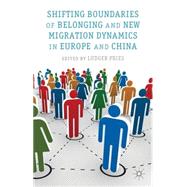In all societies significantly affected by migration, governments are rushing to adjust and implement rules and institutions so as to regulate these new forms of migration. This is accompanied by strong public discourse on how to name and characterise the newcomers and how to define who is a wanted migrant and who is unwanted.
This volume systematically explores the role that boundary making plays in creating a societal understanding of current migration dynamics and, by extension, in legitimising migration regimes. By comparing recent developments in Europe and China, it reveals insights on convergent social and political practices of boundary making under divergent conditions.









